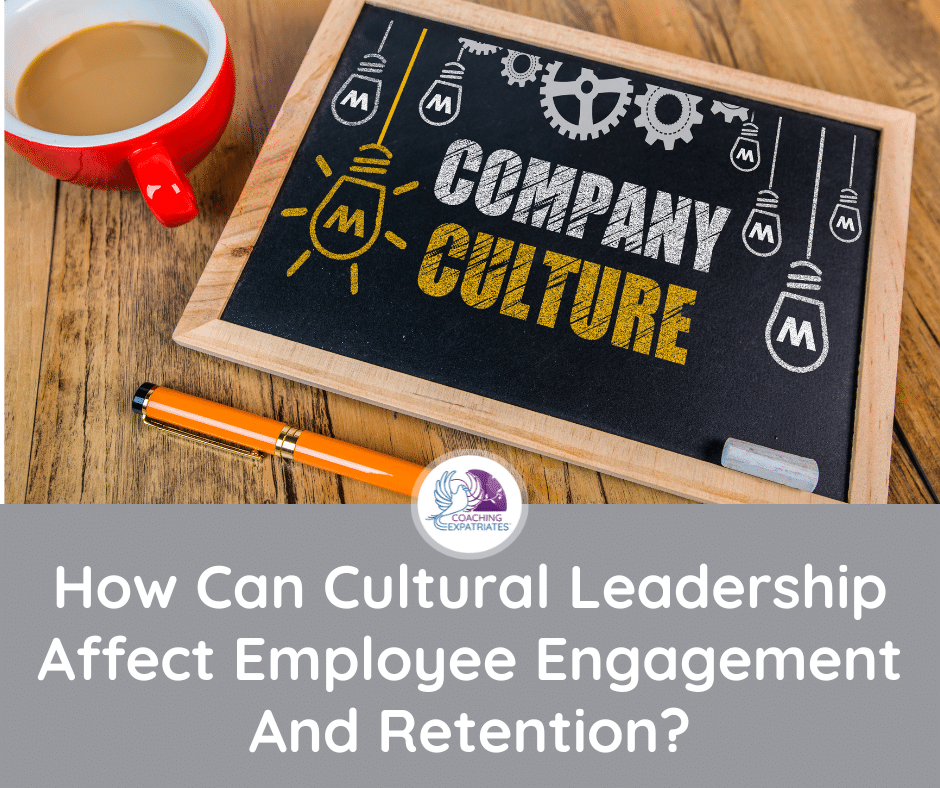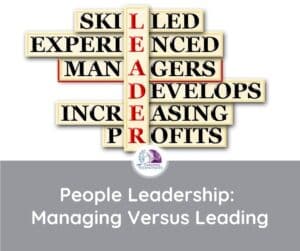Cultural leadership is essential to ensure employee engagement and retention in today’s global workplace. With a diverse workforce, organizations need to be aware of the cultural differences between employees and how they can be leveraged to create a positive working environment. Cultural leadership can help organizations foster an inclusive culture that encourages collaboration, creativity, and performance. It also helps create a sense of belonging among employees and work satisfaction, which can lead to increased engagement and retention. By gauging employee satisfaction, engagement levels, and employees’ concerns, organizations are better equipped to make decisions that will benefit everyone in the organization while retaining their best talents for a longer time. One way this can be achieved is by using employee engagement surveys, which is a method to identify how engaged or unengaged your employees are and which sectors of your company you should closely pay attention to.
Gallup research shows that engagement has been on the rise in the last decade and faced a slight plateau during Covid-19. At the same time, unengaged employees, or the so-called “quiet quitters,” were actually declining over the last decade and also faced a plateau during this bumpy period.
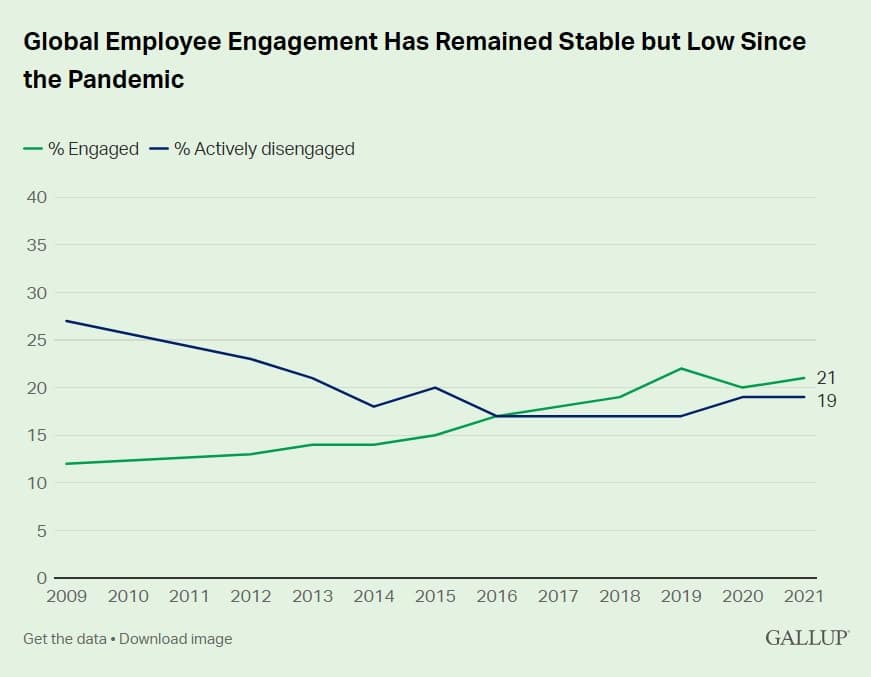
In this article, we will explore a bit about how to use cultural leadership and surveys to achieve higher retention rates, employee engagement, and company goals in international organizations. This is one of the top concerns and focuses for most successful global executives, which is the main reason why we want to drill down here.
What Is An Employee Engagement And Retention Survey?
I was recently discussing with an organization leader about his employees’ engagement. He never gave much thought to it before, but after the whole ‘quiet quitting’ repercussion of TikTok in the media outlets, he started being pressured by his board to do so.
Well, it turns out that he wanted to find a way to pinpoint the quiet quitters and cast them out. Problem solved. Right? I confess that I saw that coming. Not from him, specifically, but from all leaders who think like him.
No, not right. It’s not that simple. The quiet quitter, who is simply an unengaged employee, might actually become quite the corporate talent once engaged.
What would you think costs more? To engage a talented employee or to hire a new one, who could also turn out to be a bust?
Hear the educated opinion from a lady who worked with financial planning and analysis for over 2 decades, on top of HR: hiring talented folks costs more than engaging talented people already in the organization.
It’s much better to find a way to engage or re-engage employees than start from scratch with a new one. You can start the engagement process by surveying your employees through something called “employee engagement surveys.”
Also known as Employee Engagement And Retention Survey, these surveys are used by companies to measure the level of engagement among their workforce. They are often distributed via email or as part of a company-wide meeting and can be used to gauge the level of satisfaction with various aspects of an employee’s job, such as pay, benefits, work environment, and job satisfaction. The overall results from these employee engagement survey questions are often cross-referenced with company metrics like employee turnover rates, to identify how general engagement and satisfaction can be translated into employee retention. This helps the leadership understand trends and create specific actions to engage the employees and retain talents.
What Is Cultural Leadership?
Cultural Leadership is the ability to drive culture and values to influence stakeholders and communities to create a positive, inclusive, and engaging working environment. In other words, Cultural Leadership leads Behavior. After all, any business needs the right behavioral patterns from its employees for it to grow, prosper and become a positive, happy working environment.
For anyone to achieve strong cultural leadership, they have to work on several key competencies and skills. Cultural Leadership is one of the 4 pillars in The Global Leadership Pillars™ methodology, and is part of a new global mindset for leading international businesses.
You can read our full article on cultural leadership, where we explain in details the skills and competencies needed to improve this kind of leadership so it can be helpful to your company and your career.
Why Is An Employee Engagement And Retention Survey Important For Stronger Cultural Leadership?
There are 6 compelling reasons why you should have a systematic employee survey in your organization. Let’s talk about them:
Reason #1: It's Cost-Effective.
It’s more cost-effective to focus on engaging and re-engaging good employees than witch-hunting and casting out the unengaged employees. This applies to both blue-collar and white-collar workers, but it’s more impactful for white collars. The firing and hiring process is costly because it is done employee by employee, while engagement initiatives can be effective while being done in bulk.
Reason #2: It Measures Engagement.
Even though the purpose of the survey in the ideal world is to be confidential and collect information as aggregated data, you can still measure employee engagement levels in specific groups, departments, or entire units and act upon them to re-engage precise sectors. You cannot act on what you can’t measure, and the survey gives you the ability to gather the right information to act upon. Having solid measures to create employee engagement strategies is crucial for a company’s success.
Reason #3: It Gives Employees A Voice.
If you ever had an opinion about something and then were shut down or unheard, you know how it feels. It sucks. And if nobody gives a damn about your opinion, you also stop caring about having one or engaging with those people at some point. Giving your employees a venue to express what they are thinking is the first step to re-engaging them. If you act upon what they voiced, they will feel heard, and, in time, they will start caring again. I did not say liking or engaging. I said, caring. But it’s the first step towards engagement.
Reason #4: It Helps Increase Employee Engagement.
When you measure, you can start acting to understand what’s happening. When you gain understanding and awareness, you can start planning ways to U-turn the situation. Sounds simple, and it is. I did not say easy; I said simple. If you don’t know where it’s leaking, you can never fix the hole from where it’s leaking, and at some point, you’ll sink. This means surveying is a way to start measuring, understanding, and creating employee engagement strategies.
Reason #5: It Starts The Right Conversations.
Surveys show data that helps the top leadership team to focus on the right initiatives. If you know you have a problem with A, you can then make educated decisions about whether you’ll invest time and money on A initiative or B initiative first. Or even better: you’ll start to create a pipeline of initiatives with a proper budget for each and a timeline for implementation.
These types of conversations would never happen in the first place, if you did not learn that initiative A should exist in the first place. This is the product of having a survey in place. In other words, employee engagement and retention surveys are tools for stronger cultural leadership. You cannot lead a culture if you don’t have the right tools that show you what to do or which direction to go.
Reason #6: It Gives You A Baseline.
When working with data, a baseline is like an anchor. The anchor temporarily parks you in a place so that you can compare other similar data. Every survey gives you a baseline for comparison and help you predict trends. Either with other surveys in the market, in your sector, other departments inside your own organization, or even previous surveys in your organization.
Reason #7: It Shows You Trends.
Surveys also give you the power to see trends. As a leader, you won’t be able to fix things overnight. But when you start to see positive trends, you can share them with your stakeholders (like your board) and show the effectiveness of your actions. If you see negative trends, you can quickly act upon them and u-turn any situation before greater damage to the organization.
Implementing surveys like this is not the easiest thing to do, though. It requires budget, time, effort, and a lot of planning. Planning for tools, formats, topics, timelines, pre & post-communication, data collection and analysis, and so on. This type of initiative can take 6 months to over a year to start seeing the first data points, depending on the size of the organization. So it’s not quick, and it’s not easy, but it’s well worth it to lead a lasting and effective organizational culture.
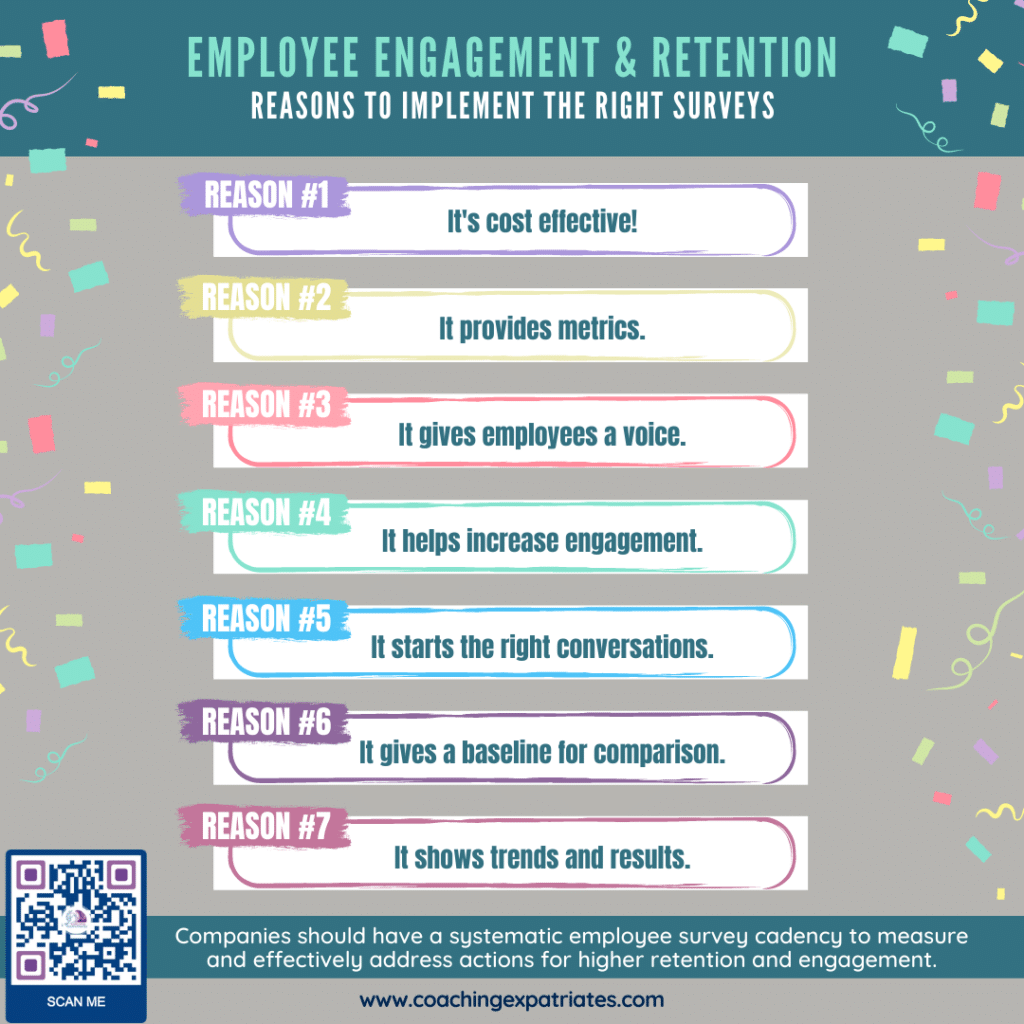
Main Drivers Of Employee Engagement And Retention
There are a few drivers that can affect the levels of employee engagement. Any good retention strategy usually tries to touch some or all of these drivers to quickly detect employee sentiment, act upon them, and ensure retention rates always remain high. Here are the main drivers:
- Job satisfaction – this can include things like the work itself and job description, and the tools employees have at their disposal to perform their job.
- Meaning & Purpose – this can be their personal motivations and purposes for that job activity, but also the value attribution the company gives to their work. Nobody likes to work in a job where their activities do not matter or when they are never recognized and celebrated.
- Company Culture – this includes not only the letter of the culture (i.e. what’s written in the company’s culture playbook) but also the spirit (i.e what really happens in the corridors). After all. company values are not only those things written on those onboarding papers but also what happens in everyday situations.
- Work Environment – this includes the physical environment but also the emotional and psychological aspects of that environment. Work stability, frequency of changes, transparency, diversity, equity, inclusion, and fairness, amongst other things, can affect emotional and psychological aspects that impact the way the work environment is perceived.
- Career Development Opportunities – this includes not only career path transparency and the opportunities given to employees for professional growth, but also the training and experience provided so that they can grow their own opportunities and careers. It also involves helping each employee adequately set their own career goals. Clarity brings a driven purpose and creates a positive impact on the employee lifecycle and even in their personal life.
- Management & Leadership – this includes not only the immediate manager but also middle and high leadership up to the CEO. How trustworthy leadership and management are perceived in general can affect how engaged employees are.
- Workload Management – this includes how well management and leadership manage workload and how much they care about managing employees that are burned out or affected by poor workload management.
- Power Balance – every company has power struggles that will affect employee morale and engagement and, sometimes, employee trust in the top leadership. Power balance can be between the employees themselves and their managers or between 2 managers or 2 departments.
How you handle all these factors and the behaviors behind them is what creates a company’s cultural leadership.
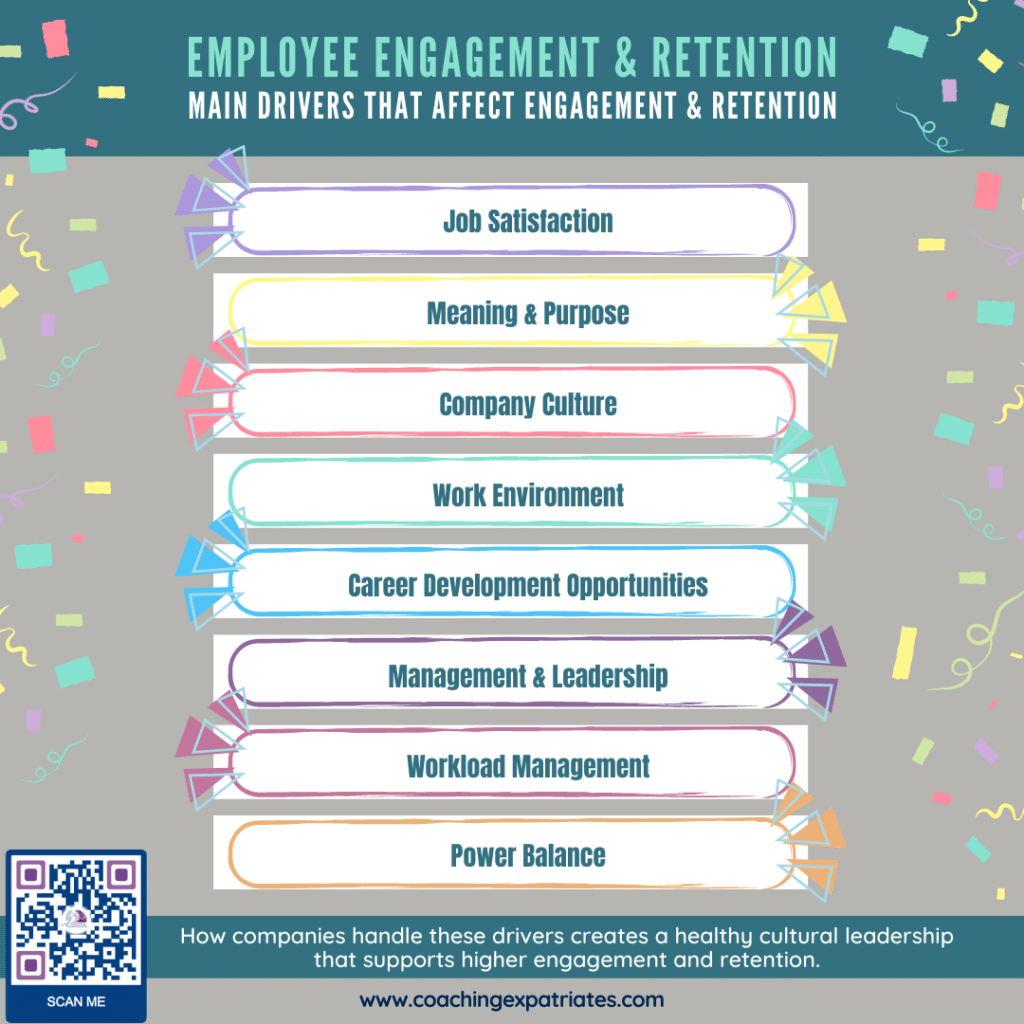
How Does Engagement Increase Productivity And Employee Retention?
Employee engagement is critical to productivity and employee retention in any organization. When employees are engaged, they are motivated and committed to their work, leading to higher levels of productivity and job satisfaction. Here are a few ways in which employee engagement can increase productivity and retention:
- Increased Motivation: Engaged employees are more motivated to perform at their best. They feel invested in the success of their organization and take pride in their work, which results in improved productivity.
- Stronger Sense of Belonging: Engaged employees feel part of a team and have a stronger sense of belonging in their organization. This feeling of community and belonging can improve employee morale, and how happy employees feel, which reduces turnover.
- Clearer Understanding of Goals: When employees are engaged, they have a clearer understanding of their role and their organization’s goals. This clarity helps them focus their efforts and work towards achieving company objectives and also their own career goals.
- Improved Communication: Engaged employees are more likely to communicate effectively with their multicultural colleagues and managers. This leads to a better understanding of expectations and improved teamwork, resulting in higher levels of productivity and retention.
- Expanded Opportunities for Development: Engaged employees are more likely to take advantage of the development opportunities offered by their organization. This can include training, mentorship, and professional coaching, which can all improve their skills and knowledge, leading to increased productivity and job satisfaction.
- Heightened Focus & Attention: Because engaged employees care about their work and are committed to their teams, they naturally have an increased focus and attention to details and their overall job. This can mean many things: fewer errors, greater productivity, or better quality of work.
- Fewer Errors & Omissions: yep, one thing leads to another, fewer errors and omissions happen because engaged and happy employees usually are more focused and attentive while performing their tasks and jobs.
- More Profitable & Impactful Decisions: the cherry on top of the cake from all these things is the greater profitability and how impactful decisions can be in an organization. Think about this: you have happy employees, who are engaged and satisfied with their jobs, they are attentive and focused, they go above and beyond to achieve their goals, and they have a great sense of belonging… In a nutshell, what we have is good decisions and behaviors that lead to profitable results.
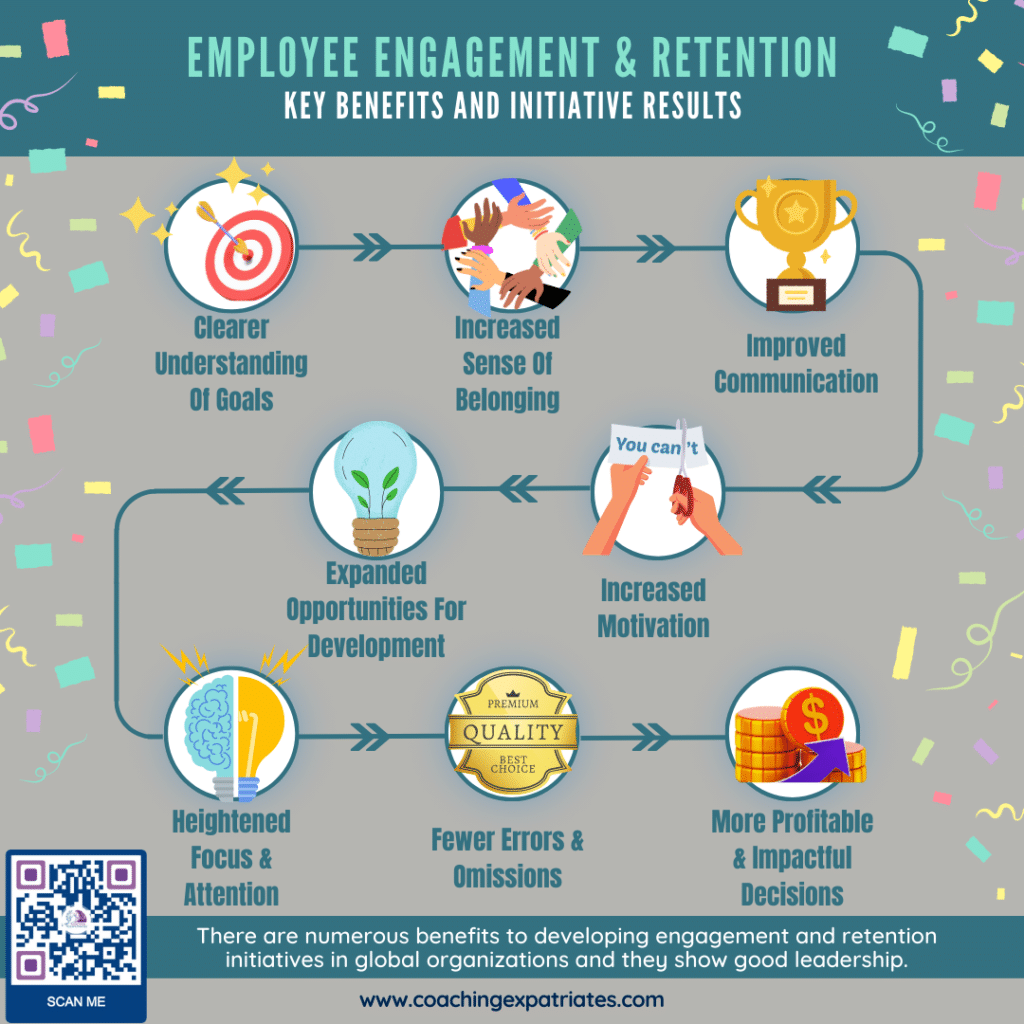
As you can see, employee engagement is a critical driver of productivity and employee retention. When employees are engaged, they are motivated, committed, and invested in the success of their organization, which can lead to improved productivity and even job satisfaction.
How Can Uncertainty Affect Employee Engagement And Retention?
In all these factors, the way uncertainty plays a role is by creating a gap in expectations. Employee engagement will depend on how big this gap is. If too big, engagement is low. If small, engagement will be higher because things are happening according to their expectations.
Things are like this everywhere, if you think about it. Think about your significant other, for example. If you were expecting flowers but got the cold shoulder instead, would you be happy and engaged in the relationship or mad and disgruntled?
Gaps of expectations create uncertainty. Period. If you are expecting flowers and get the cold shoulder, you will feel anxious and start to second guess what’s going on. You’ll probably make dangerous assumptions too. Are they cheating? Are they hiding something? Will they break up?
When gaps in expectations happen, it’s when the perception of uncertainty is formed. And it goes on until the matter is sorted out, or it becomes too big of a deal to be cleanly solved.
Companies are no different.
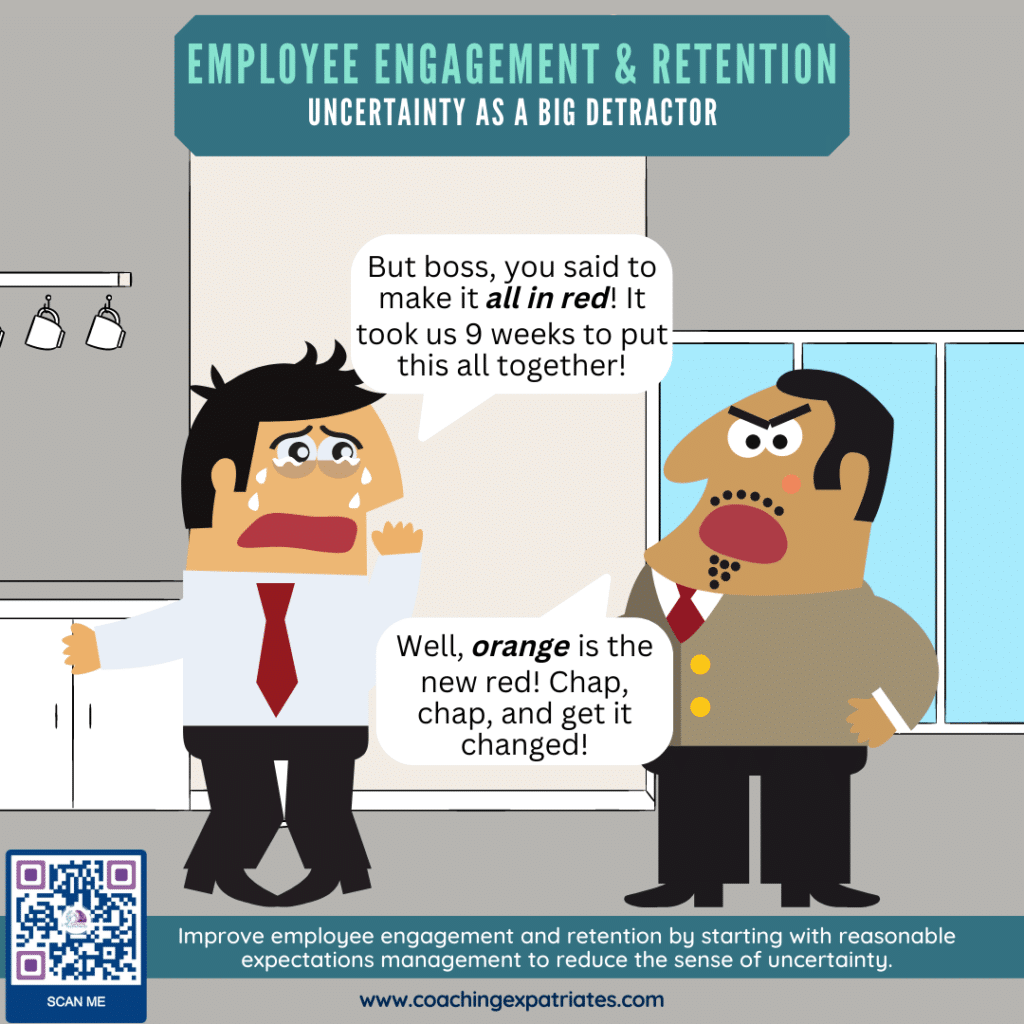
Companies can do many actionable things to ensure their employees are more engaged. Studies show that employee engagement strongly predicts how well a company will face turbulent times. More engaged employees showed higher resilience during difficult times, which helped companies drive better results in these ambiguous situations. Although there are many strategies and actionable things to achieve this, they all boil down to managing expectations well to reduce this perception of uncertainty and randomness.
What Are Actionable Strategies To Engage Employees
We put together a complete guide on retaining employees using engagement strategies. It’s highly recommendable to check it out if you are in the business of engaging and retaining employees.
To provide you with loads of value in this article, here are some key actionable initiatives that organizations can use to improve employee engagement:
- Provide Opportunities For Professional Development: Offer employees training, mentorship, and coaching to help them develop new skills and grow in their roles. This can help them feel invested in their organization and improve their job satisfaction.
- Foster A Positive Work Environment: Create a supportive, respectful, and inclusive workplace. This can include promoting work-life balance policies, recognizing employee achievements, and encouraging teamwork.
- Encourage Feedback And Communication: Create open communication and feedback channels between employees and managers. Many managers have already learned how to provide constructive feedback to their employees, but they also need to be open to receiving feedback from them. Encourage employees to share their thoughts and ideas. And on top of that, make sure once they share their thoughts, the receiver act on this feedback, to show that their employee’s opinions are valued.
- Offer Employee Recognition And Rewards: Recognize employees for their achievements and contributions to the organization. This can include bonuses, awards, or other forms of recognition. Check our recent guide on celebrating success in global corporations.
- Promote Work-Life Balance: Support employees in achieving a healthy work-life balance by offering flexible schedules, remote work options, and time off.
- Encourage Collaboration And Teamwork: Foster a culture of collaboration and teamwork, and create opportunities for employees to work together on projects or initiatives. This can improve morale and create a sense of belonging within the organization.
- Provide Opportunities For Social Connection: Create opportunities for employees to connect socially, both in and out of the workplace. This can include social events, team-building activities, and volunteer opportunities. Many employees might say this does not matter, but when it does not happen at all, they actually miss it. During Covid-19 restrictions, many employees reported feeling lonely and deprived of connection with their peers and managers because any in-person interactions were happening.
Engaging employees requires a multifaceted approach that takes into account the unique needs and preferences of the workforce. By implementing strategies that prioritize employee development, recognition, and work-life balance, organizations can create a more engaged and motivated workforce.
What's The Leadership Role In Employee Engagement And Retention?
The leadership role in employee engagement is an important people leadership aspect and relates to reducing the gap in expectations that employees might have about the various significant topics the work environment presents. As we mentioned before, this reduces the sense of uncertainty and improves engagement. There are a few specific actions leadership can take to reduce this gap.
- Hire the right talents for your organization.
- Create an open and supportive work environment.
- Reduce gaps in the Cultural drivers’ spirit and letter of the company.
- Provide equal access to career opportunities and growth challenges.
- Supply functional and soft-skills training.
- Promote engaged, motivated, and emotionally intelligent employees.
- Train employees on multicultural communication styles, forms, and strategies.
- Facilitate 360-degree communication.
- Lay out 2-way constructive feedback opportunities and processes.
- Encourage the sharing of information, ideas, and opinions.
- Manage individual contributors and the team’s workload.
- Build trusting relationships considering cultural backgrounds.
- Quickly solve conflicts and power imbalances.
- Provide recognition.
- Celebrate success.
What Should Be Included In An Engagement Survey?
An engagement survey is a tool used by organizations to assess the level of engagement and satisfaction among their employees. It typically includes a series of questions that cover a range of topics related to employee experiences, such as job satisfaction, work environment, communication, leadership, and opportunities for growth and development. Here are some of the key components that should be included in an engagement survey:
- Job Satisfaction: This includes questions related to employee satisfaction with their job duties, workload, and compensation.
- Work Environment: This includes questions related to the physical work environment, such as the cleanliness and safety of the workplace, as well as the organizational culture and sense of belonging.
- Communication: This includes questions related to the quality and frequency of communication from management, as well as opportunities for employees to provide feedback and express concerns.
- Leadership: This includes questions related to employees’ perception of the quality of leadership within the organization, including issues such as trust, transparency, decision-making, and power struggles.
- Opportunities For Growth and Development: This includes questions about the availability and effectiveness of training, mentorship, and other professional development opportunities.
- Work-Life Balance: This includes questions related to the flexibility and support provided by the organization to help employees achieve a healthy work-life balance.
- Employee Recognition and Rewards: This includes questions related to the effectiveness of employee recognition and reward programs, as well as the perceived fairness of compensation, benefits, and rewards.
In a nutshell, an effective engagement survey should be comprehensive and cover a range of topics related to employee experience. It should also include a mix of open-ended and close-ended questions to allow for both quantitative and qualitative analysis. The results of the survey should be used to identify areas for improvement and develop action plans to address any issues identified.
One important side note is about the frequency of the surveys and the number of questions in each of the surveys. If you had 3 questions for each of these 7 topics, you’d have a survey with 21 questions. That’s a lot for most people.
According to Great Place To Work, many companies survey their employees at least once per year or more. It all depends on the company’s objective. You can split these 7 topics into 3 or 4 groups and survey them throughout the year independently, in rotations, in what’s called “Pulse surveys,” which are quick surveys to gauge something specific.
What’s important is to avoid survey fatigue, according to ProProfs Survey. They recommend having surveys that take between 2 and 3 minutes to respond to. That sounds pretty reasonable, right? I’d be ok to answer a survey that would take only this long; how about you?
What Are The Main Providers For Employee Engagement And Retention Surveys?
There are many providers of employee engagement and retention surveys, each with its own unique approach and methodology. Here are some of the main providers:
- Gallup: Gallup is a global analytics and consulting company that offers a range of employee engagement surveys and services. Their surveys focus on the 12 key elements of employee engagement, including leadership, communication, and career development.
- Qualtrics: Qualtrics is an experience management platform that offers a range of employee engagement and retention surveys. Their surveys cover topics such as employee experience, leadership, and feedback.
- Culture Amp: Culture Amp is an employee feedback and analytics platform that offers a range of engagement surveys, including employee engagement, pulse, and lifecycle surveys. Their surveys focus on organizational culture, leadership, and career development.
- SurveyMonkey: SurveyMonkey is an online survey platform that offers a range of employee engagement and retention surveys. Their surveys cover topics such as employee satisfaction, communication, and work-life balance.
- Glint (a LinkedIn company): Glint is an employee engagement platform that uses pulse surveys to measure employee engagement and provide real-time insights to managers. Their surveys cover topics such as leadership, employee development, and communication.
- Peakon: Peakon is an employee engagement platform that offers a range of surveys, including pulse surveys, onboarding surveys, and exit surveys. Their surveys cover topics such as employee satisfaction, leadership, and work-life balance.
- Perceptyx: Perceptyx is an employee feedback and survey platform that offers a range of employee engagement and retention surveys. Their surveys cover topics such as employee satisfaction, leadership, and employee development.
- TINYpulse (a Glint company): TINYpulse is an employee engagement platform that offers pulse surveys, employee recognition tools, and feedback channels. Their surveys focus on employee happiness, leadership, and communication.
- CultureIQ: CultureIQ is an employee engagement platform that offers a range of surveys, including engagement surveys, pulse surveys, and culture assessments. Their surveys cover topics such as leadership, communication, and employee development.
Overall, the choice of provider will drastically depend on the specific needs, focus points, and preferences of the organization. It is important to choose a provider that has specific experience in the area of employee engagement and retention and can offer a survey that is tailored to the needs of the organization. It is also critical to choose a provider that can offer actionable insights, data analysis, and support in implementing changes based on the survey results. After all, surveys without actions are like empty promises.
Final Remarks
Cultural leadership plays an important role in increasing employee engagement and retention. It helps to create a sense of belonging, trust, and loyalty among employees, which in turn increases job satisfaction and commitment. Cultural leadership also helps companies to build a global network of talented professionals who can help them achieve their goals. Moreover, cultural leadership is essential for developing an inclusive and multicultural environment that allows employees to feel valued and respected. By implementing effective cultural leadership strategies with engagement in mind, companies can ensure that their employees remained longer and committed to the organization’s mission.
If you are looking for a business partner and consultant to help you implement some of these strategies, you can hire me as your executive and development coach. Have a free strategy call with me. We will go over your organization’s data and devise together the top priority initiatives and their budgets.
If you are interested in developing specific global leadership skills, on top of HR Strategies, check out our online Global Executive Leadership Program. We go over all 4 pillars in The Global Leadership Pillars™ leadership methodology, during 9 online modules, specially meant for global leadership.
If you enjoyed this post, consider subscribing to our newsletter using the form below. We focus on providing good content to global leaders and executives who want to make impactful business decisions and be more inclusive and influential. We know your inbox is sacred, so we email just once per week, and we never sell your information. Trust is the basis of Global Leadership, and we fully honor it.

